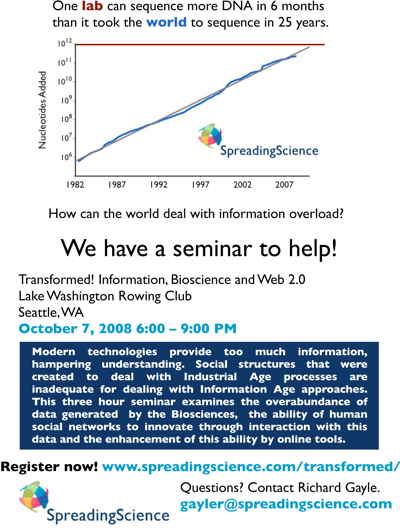I’ve put together a nice handout regarding the seminar – Transformed! Information, Bioscience and Web 2.0. Take a look:

You can also download a copy.
Technorati Tags: Social media, Web 2.0
I’ve put together a nice handout regarding the seminar – Transformed! Information, Bioscience and Web 2.0. Take a look:

You can also download a copy.
Technorati Tags: Social media, Web 2.0
 by tanakawho
by tanakawho
Digital intimacy:
[Via Bench Marks]
Recently, the NY Times had an article discussing the concept of “ambient awareness”, or as the article puts it, “incessant online contact”. Now, first off, I have to admit that I’m one of the over-30-year-olds the article mentions, who finds the concept of subjecting others to (and being subjected to) a stream of trivial details about one’s day completely unappealing. The proponents of Twitter and FriendFeed and the like feel that they’re getting a more intimate understanding of people, “something raw about my friends,” as one user puts it. I’m more in line with the critics quoted in the article that the end result is more “parasocial” than social, and that it ends up an extension of reading gossip magazines and following celebrities from afar.
So how do these new practices apply to the world of science research?
[More]
David always brings up really good points to discuss. I don’t expect every scientist will want or need to be a direct part of the ‘conversation’ happening on Twiiter or FriendFeed. Few have the time. But it will be important that the social network (ie. lab, department, etc.) they belong to includes people who are connected.
These tools are rapidly becoming a part of how human communities disperse information. This decreases the diameter of a social network tremendously, meaning information of every type has to traverse fewer nodes.
Research networks that normally involved publications, seminars, conferences, etc. will also include these social media approaches. Because labs that remain unconnected will not be able to compete with labs that do use these tools to decrease the diameter of their sphere of collaborations and fid out about relevant information faster.
These tools are just part of finding out what is happening in relevant fields. I’ll give an example of how these tools can help move information in ways not possible before.
I had looked a little bit at FriendFeed but just did not have the time to really dig. Then I noticed that there were a lot of hits at my website that were being referred from the Science 2.0 room.
Turns out they were having a conversation about my site and were asking a lot of questions, trying to get an idea of who I was , my reputation, etc. Seeing the conversation, I quickly joined and helped answer questions. Now I am a part of a group I can check in on every so often that does a great job finding and providing information I find useful.
Like any social setting, I introduced myself, answered some questions and provided insight. Now I am connected to a group that provides very useful information for me.
I don’t have to check it constantly to be able to see useful items that I would not have if I were not part of this particular conversation.
Human social networks are exceptionally great filters of information. The huge amounts of information being created today require human networks to help filter and disperse the info. These tools are simply one part.
All that will really be necessary is for a scientist just to be part of a research network, even just a lab, in which someone is connected to these online sites. What is important is the rate at which this information diffuses throughout the group, not that everyone in the group is connected to Twitter.
Each person in a network often has their own role, their own diverse viewpoint that helps the group. The best tools will be ones that allow people to use them for their own purposes and needs. They do not work by forcing everyone to join.
But they do work by spreading information farther and faster.
Technorati Tags: Social media, Web 2.0